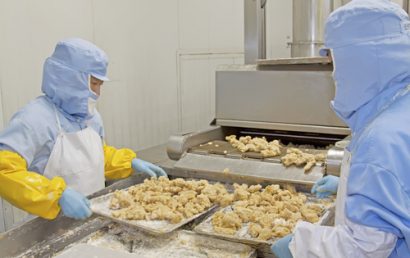Getting to Know the Different Types of Conveyors
Conveyors come in many shapes, sizes, and types, and are made of different kinds of materials for various applications. Let’s take a look at how some of the most common conveyors operate, in what capacity they operate, and what they are made of.
Conveyors In General
To put it simply, conveyors are assemblies or mechanical devices utilized in the movement of packages using the least effort possible. Ordinarily, they can consist of belts, wheels, rollers, frames, and can be either manual or motor powered devices. They can be used to move large, bulk materials such as aggregate or gravel as well. Let’s take a closer, somewhat in-depth look at these and other kinds of conveyors used in various applications.
Wheel Variations
Manual power or gravity is what moves items along these wheeled conveyors commonly used for unloading and loading trucks, or moving pallets or packages along assembly lines or through facilities.
Walking Beam Variations
It is not uncommon to see these conveyors on assembly and automation lines where items need to be placed in a sequential manner in specific locations. The walking beam picks up the item being transferred and indexes it to its next position. There another step in manufacturing takes place.
Vibrating Variations
Linear or rotary vibration is used to move materials along the beds of these systems which come in various sizes. Typically, they are used to move coal, gravel, aggregate, etc. along the length of a flat tabletop or through a trough.
Vertical Variations
Products are moved between levels of conveying lines and vertically on these systems. They are used to move materials up to a facility’s higher levels. They can be reciprocating or continuous lifting and are available in various load capacities and sizes.
Screw Variations
Helical elements are used here to move products. Material handling applications such as chemicals, concrete, mechanical parts, bottling, and food are among the uses of these conveyors. Depending on what is being conveyed, the materials can be non-metal or metal. The screw can be of a ribbon or paddle design and can be driven by direct drive, gears, or chain and sprocket.
Roller Variations
Manual power or gravity is required to move materials along these conveyors which can be of varying widths and lengths. Resultantly, objects can move downhill and in a curved manner but not at an incline. Typically, they are used for assembly lines, in baggage handling, and on loading docks.
Powered Roller Variations
Similar to roller conveyors, these conveyors use rollers driven by motors, chains and sprockets, belts, or otherwise and are frequently used for packaging, steelmaking, food handling, and in other applications. Power requirements, axle center dimension, load capacity, and drive type will vary, depending on materials being handled and application.
Vacuum or Pneumatic Variations
Items are moved along surfaces, or through ducts or closed tubes through the use of vacuum or air pressure. Applications in which these conveyors are usually utilized can include ticket delivery, paper handling, or dust collection; and in food, scrap, mineral, and chemical processes. These conveyors are available in various sizes.
Overhead Variations
As evidenced by the name, these conveyors are ceiling mounted and use carriers or trolleys which are moved by cables, chains, or similar connections. Electricity is usually (but not always) required for the operation of this conveyor which is frequently used in applications such as parts handling systems, paint lines, and dry-cleaning garment lines. A critical factor in the use of these conveyors is load carrying capacity. Configurations can include trolley, monorail, electric track, ramped, or inclined.
Tow/Chain/Drag Variations
Products are towed or dragged along the line by cables and chains which are attached to moving members of the conveyor. Drag conveyors may have multiple loading or discharge points and typically convey bulk materials in flights, bins, or other attachments. With chain conveyors, the chain is attached directly to the product being conveyed. Tow conveyors can use chains or cables to tow dollies or wheeled carts or the product directly. If products need to be conveyed in various directions, tubular drag conveyors may be used.
Chute Variations
Moving items from one smooth surface to another, these conveyors rely solely on gravity. Typically they are found in post offices, packaging plants, and in scrap handling. Depending on the application, these chutes can be curved or straight allowing the product being moved to slide easily and move along smoothly.
Bucket Variations
Frequently used for food handling or to move bulk materials and/or parts, these conveyors use multi-sited containers which are attached to chains or cables. These conveyors come in numerous load carrying capacities and sizes, all dependent upon what is being moved and whether the system must change levels (by the altering of horizontal incline).
Beltless Magnetic Variations
As implied by the name, there is no belt used here, but rather, magnetic materials are moved by magnets beneath tables, stationary plates, etc. They are frequently utilized for moving things like machining scrap. They can be vertical, horizontal, or a combination of both and require electricity to operate.
Belt Variations
Continuous belts are used to move products along the line in material handling applications such as the postal service, scrap handling, packaging, baggage handling, food services, and others. Typically, these are electric powered and can run at various speeds as well as operating either horizontally or vertically.
Ball Transfer Variations
These conveyors are capable of moving products in a multidirectional manner using a series of unpowered, mounted ball casters. In order to move the products along the line, external forces are required. Overall conveyor width and length, ball size and material, and other specifications can determine the load capacity and intended application.
Slat or Apron Variations
To convey products, these conveyors use roller chain mounted wood, steel, or other materials. Primarily, they are used in applications for handling materials in steel mills and foundries or other heavy-duty industry settings. They can move pallets, drums, crates, and other large, heavy objects.
Because it is so important for conveyors to run and move smoothly, without hitches or snags, it is important to keep all moving parts as smooth and free from corrosion as possible. To protect your conveyors and their parts, contact us at A&A Coatings to explore the possibilities and options that can be applied to your conveyors.



